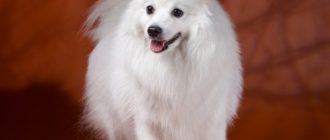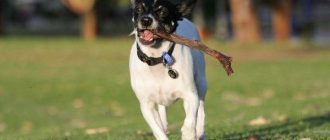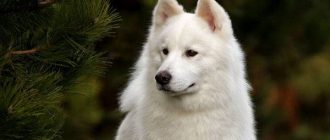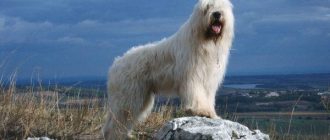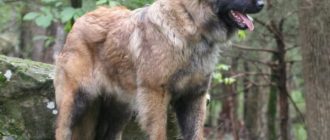Assessment of breed characteristics
Contents
| Adaptability Definition of how easy a dog is. can adapt to changes in life. |  |
| Shedding Level Level and frequency of hair loss in animal. |  |
| Level of tenderness Level and amount of tenderness and affection that the dog gives back in return for attention to itself. |  |
| Need for Exercise Daily Activity Level dogs. |  |
| Social need Required number of dog contacts with other animals as well as people. |  |
| Housing ratio Factor that determines the level of noise and other inconvenience that the dog can deliver to the owners in the ratio the size of the apartment to the size of the dog. |  |
| Grooming Number of bathing, combing, as well as necessary number of professional grooming sessions required the dog. |  |
| Friendliness in an unfamiliar environment society with strangers or in an unfamiliar environment. |  |
| The tendency to bark The tendency to bark and its frequency and volume. |  |
| Health Issues Potential Health Status dogs. |  |
| Territorial tendency of the dog to protect his house, yard or even a car owner. |  |
| Cat friendliness A trend towards cat tolerance and reduced manifestation of hunting instincts. |  |
| Intelligence Dog’s ability to think and solve emerging difficulties (not to be confused with learning!). |  |
| Education and training Level of difficulty in training a dog perform certain actions. |  |
| Friendliness for children Factor determining how much the dog friendly to children, whether she likes to play with them and endure some children’s pranks. |  |
| Game activity The concept is determined by its very name, and, usually found in almost all dogs. |  |
| Observability Dog’s ability to detect presence a stranger in his territory. |  |
| Friendliness for other dogs Dog’s tendency to find common language with other relatives. |  |
Brief description of the breed
The papillon came from a toy spaniel, dogs that you can often see in the paintings of artists of the 16th century. The growth of the papillon is 20 – 27 cm, and weight from 2 to 4.5 kg. The dimensions of the male are practically not differ from the sizes of females. The dog is very active, but also time, obedient. The mischief and unique character of the papillon makes his favorite of millions of families around the world. comes from the French word “papillon”, which translates like a butterfly. The image of this dog comes to life on the works of famous medieval artists whose paintings can be found in famous museums around the world. Literal translation of the name “butterfly” is most likely due to the fact that erect ears animals very much resemble a beautiful butterfly, which spread her wings. There is another variety of dogs of this breed, different from a butterfly with semi-permanent ears. It is noteworthy that in puppies of both varieties can be born in one brood. mistaken, believing that the small size of the dog is the key to a calm nature of the animal. If you want to have a pet that will to lie quietly on your lap, for example, while watching television series, then the papillon will not suit you. On the contrary, an animal will flit around the house, looking for what to do. Wherein the papillon is a great companion dog for a long time will become your faithful friend. Papillons are very vigilant and careful, especially in relation to larger relatives. Wherein representatives of this breed are often used as watchdogs dogs. They do an excellent job with this task, forgetting about their size and physical capabilities. Animals of this breed as much as possible suitable for active and sociable people, because the papillon adores human society. Small pet sizes indicate simplicity caring for a dog. Despite the relatively long coat, as well as that she is prone to molt, to care for the hair of the animal quite simple. It’s a miracle – dogs are also suitable for those who wants to raise a pet ready to participate in various sports competitions. Dogs are also eager to engage in various challenging team competitions. By nature papillons are the owners. They also have stubbornness. Therefore important start educating and socializing the puppy from the first days his appearance in the house. The undoubted advantage of all papillons is desire and desire to learn new things. Dogs are easy to train and always joyfully execute commands. Representatives of this breed are well get along with other pets, including cats. The most important thing is to teach your puppy to live together from an early age. age. Papillons adore children. True, the friendship of the baby and the little doggies can bring negative effects. The fact is that these small dogs can bite a child if they feel that they pain may be inflicted. Therefore, do not leave children and a dog unattended. Animals of this breed belong to centenarians. When buying such a puppy, you can be sure that he will become a true friend for many years. Papillon is extremely popular and common breed. At the same time get a little friend, sometimes difficult. The reason for this is a small number of puppies per one offspring.
Papillon photo:





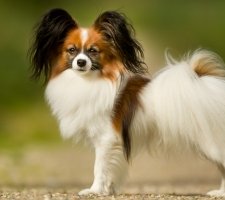

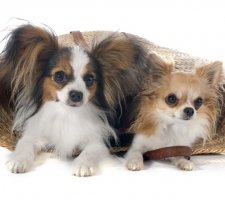
 Photo of dogs of breed Papillon |
Photo of dogs of breed Papillon |
Origin history
The history of the papillon has more than one hundred years. This whole period animals were reliable friends of man. That is why for papillon is of great importance the company of man. If you are looking active, fun and loyal friend, then this breed is for you will do. We already mentioned that papillons were often depicted on paintings of famous artists of the 16th century. This evidence is not only popularity, but also the special status of animals. Rubens, Watteau, Boucher, Van Dyck, Rembrandt, Fragonard and other brush masters immortalized papillon in their masterpieces. In pictures, animals are usually portrayed in the arms of his affectionate mistress. These dogs were favorite pets of medieval court ladies of Europe. Merchants transported papillons in baskets from different countries, including from France, Italy, Spain. Original toy spaniels, from which breed occurred, had drooping ears. At the beginning of the 17th century at court Louis XIV was bred puppy with erect ears that very reminiscent of a butterfly with outstretched wings. So it appeared papillon. These dogs were known under other names: dwarf continental spaniel, squirrel dog (due to similarities tail of a dog with a tail of a squirrel), Belgian toy spaniel and In addition to the ears, the color of the dogs also changed somewhat. Originally toy spaniels were monophonic, today papillons may possess different colors (usually white with spots of different colors). But in general papillons depicted in paintings in the famous the French Museum – the Louvre, is practically no different from his contemporary relative. Today the papillon takes thirty fifth among 155 breeds registered American Kennel Club.
Papillon character
The name “papillon” in translation from French means “butterfly.” The breed got its name due to the special shape of the ears, like a butterfly. Representatives of this breed are very active. They are I love to play with the ball and run, although they spend it with pleasure time in a relaxed atmosphere with your master. These dogs are more likely just quickly grasp everything that they are taught. Particular success achieve obedience and agility. Papillons are an excellent choice for beginner breeders.
Maintenance and care
Despite the rather thick hair of the papillons, not so much behind them difficult to care for. These dogs do not emit a characteristic odor. You need to comb them two to three times a week. Bathe papillons as necessary. The coat of these dogs is not prone to copious loss, but the combing process itself is necessary in order to The dog’s coat looked healthy and beautiful. Occasionally Papillons need to be trimmed. It’s easy to do, even at home, without the help of professionals. Papillon ears need systematically check for infections, irritations and pollution. The ears must be cleaned with a special solution, appointed by a veterinarian, with no need to use cotton tampon for cleaning the ear canal. Weekly brushing prevent the occurrence of tartar, as well as unpleasant bad breath. Claws are trimmed as needed, usually do it monthly.
Training and training
Papillons are easy to train. They are full of special desire. please your master. The sharp mind of these dog allows you to grasp some teams in one session. Some papillons may be stubborn, so you should not think that Your dog does not match the breed. Food can be good motivator in training a pet. After mastering the basic teams and skills, many owners of papillons hand them in special schools for deeper, “professional” training. Highly often representatives of this wonderful breed become winners of various competitions, especially when it comes to agility or obedience competition.
Health and Disease
The average life expectancy of papillons is 13-17 years. TO The main health problems of dogs of this breed include: dislocation patella, follicular dysplasia, congenital deafness, eyelid inversion, cataract and progressive retinal atrophy.

